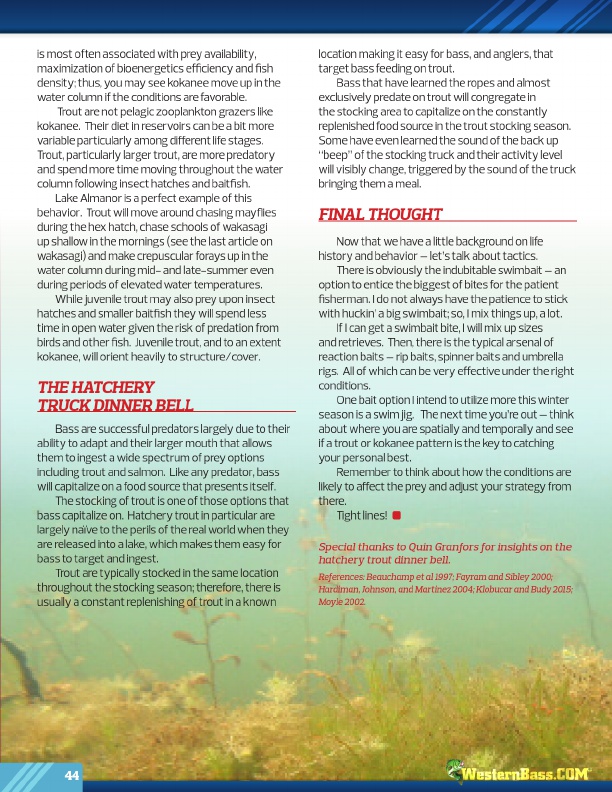
®
is most often associated with prey availability, maximization of bioenergetics efficiency and fish density; thus, you may see kokanee move up in the water column if the conditions are favorable.
Trout are not pelagic zooplankton grazers like kokanee. Their diet in reservoirs can be a bit more variable particularly among different life stages. Trout, particularly larger trout, are more predatory and spend more time moving throughout the water column following insect hatches and baitfish.
Lake Almanor is a perfect example of this behavior. Trout will move around chasing mayflies during the hex hatch, chase schools of wakasagi up shallow in the mornings (see the last article on wakasagi) and make crepuscular forays up in the water column during mid- and late-summer even during periods of elevated water temperatures.
While juvenile trout may also prey upon insect hatches and smaller baitfish they will spend less time in open water given the risk of predation from birds and other fish. Juvenile trout, and to an extent kokanee, will orient heavily to structure/cover.
THE HATCHERY TRUCK DINNER BELL
Bass are successful predators largely due to their ability to adapt and their larger mouth that allows them to ingest a wide spectrum of prey options including trout and salmon. Like any predator, bass will capitalize on a food source that presents itself.
The stocking of trout is one of those options that bass capitalize on. Hatchery trout in particular are largely naïve to the perils of the real world when they are released into a lake, which makes them easy for bass to target and ingest.
Trout are typically stocked in the same location throughout the stocking season; therefore, there is usually a constant replenishing of trout in a known
location making it easy for bass, and anglers, that target bass feeding on trout.
Bass that have learned the ropes and almost exclusively predate on trout will congregate in the stocking area to capitalize on the constantly replenished food source in the trout stocking season. Some have even learned the sound of the back up “beep” of the stocking truck and their activity level will visibly change, triggered by the sound of the truck bringing them a meal.
FINAL THOUGHT
Now that we have a little background on life history and behavior – let’s talk about tactics.
There is obviously the indubitable swimbait – an option to entice the biggest of bites for the patient fisherman. I do not always have the patience to stick with huckin’ a big swimbait; so, I mix things up, a lot.
If I can get a swimbait bite, I will mix up sizes and retrieves. Then, there is the typical arsenal of reaction baits – rip baits, spinner baits and umbrella rigs. All of which can be very effective under the right conditions.
One bait option I intend to utilize more this winter season is a swim jig. The next time you’re out – think about where you are spatially and temporally and see if a trout or kokanee pattern is the key to catching your personal best.
Remember to think about how the conditions are likely to affect the prey and adjust your strategy from there.
Tight lines!
Special thanks to Quin Granfors for insights on the hatchery trout dinner bell.
References: Beauchamp et al 1997; Fayram and Sibley 2000; Hardiman, Johnson, and Martinez 2004; Klobucar and Budy 2015; Moyle 2002.
44